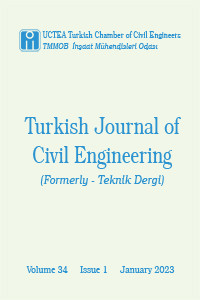Investigation of Pounding between Two Adjacent Building Models with Experimental Methods
Investigation of Pounding between Two Adjacent Building Models with Experimental Methods
___
- Miari, M., Choong, K. K., Jankowski, R., Seismic pounding between adjacent buildings: Identification of parameters, soil interaction issues and mitigation measures, Soil Dynamics and Earthquake Engineering, 121, 135-150, 2019. doi: 10.1016/j.soildyn.2019.02.024.
- Turkish Building Earthquake Code (TBEC). Turkish Ministry of Environment and Urbanisation, Ankara, 2018.
- Anagnostopoulos, S. A., Pounding of buildings in series during earthquakes, Earthquake Engineering & Structural Dynamics, 16(3), 443–456, 1988. doi: 10.1002/eqe.4290160311.
- Kumbasar, N., Collision Problem of Shear Frames During Earthquakes (in Turkish), Teknik Dergi, 4(16), 609–617, 1993.
- Zhang, Y., Ding, J., Zhuang, H., Chang, Y., Chen, P., Zhang, X., Xie, W., Fan, J., Pounding between Adjacent Frame Structures under Earthquake Excitation Based on Transfer Matrix Method of Multibody Systems, Advances in Civil Engineering. 2019. doi: 10.1155/2019/5706015.
- Saxena, N., Ghosh, R., Debbarma, R., Analysis of seismic separation gap between two adjacent reinforced concrete buildings, AIP Conference Proceedings, 2019: 2158(September). doi: 10.1063/1.5127126.
- Khatami, M., Gerami, M., Kheyroddin, A., Siahpolo, N., The Effect of Irregularity of Lateral Stiffness in Estimating the Separation Gap of Adjacent Frames, KSCE Journal of Civil Engineering, 24(1), 166–177, 2020. doi: 10.1007/s12205-020-0173-4.
- Khatami, M., Gerami, M., Kheyroddin, A., Siahpolo, N., The Effect of the Mainshock-Aftershock on the Estimation of the Separation Gap of Regular and Irregular Adjacent Structures with the Soft Story, Journal of Earthquake and Tsunami, 14(2), 1–25, 2020. doi: 10.1142/S1793431120500086.
- Takabatake, H., Yasui, M., Nakagawa, Y. and Kishida, A., Relaxation method for pounding action between adjacent buildings at expansion joint, Earthquake Engineering & Structural Dynamics, 43(9), 1381–1400, 2014. doi: 10.1002/eqe.2402.
- Anagnostopoulos, S.A., Spiliopoulos, K.V., An investigation of earthquake induced pounding between adjacent buildings, Earthquake Engineering & Structural Dynamics, 21(4), 89–302, 1992. 2doi: 10.1002/eqe.4290210402.
- Jankowski, R., Non-linear viscoelastic modelling of earthquake-induced structural pounding, Earthquake Engineering and Structural Dynamics, 34(6), 595–611, 2005. doi: 10.1002/eqe.434.
- Jankowski, R., Analytical expression between the impact damping ratio and the coefficient of restitution in the non-linear viscoelastic model of structural pounding, Earthquake Engineering and Structural Dynamics, 35(4), 517–524, 2006. doi: 10.1002/eqe.537.
- Kharazian, A., López-Almansa, F., State-of-the-Art of Research on Seismic Pounding Between Buildings with Aligned Slabs, Archives of Computational Methods in Engineering, 26(2), 327–345, 2019. doi: 10.1007/s11831-017-9242-3.
- Khatiwada, S., Chouw, N., Butterworth, J.W., Evaluation of numerical pounding models with experimental validation, Bulletin of the New Zealand Society for Earthquake Engineering, 46(3), 117–130, 2013. doi: 10.5459/bnzsee.46.3.117-130.
- Miari, M., Jankowski, R., Shaking table experimental study on pounding between adjacent structures founded on different soil types, Structures, 44, 851-879, 2022. doi:10.1016/j.istruc.2022.08.059.
- Athanassiadou, C.J., Penelis, G.G., Kappos, A.J., Seismic Response of Adjacent Buildings with Similar or Different Dynamic Characteristics, Earthquake Spectra, 10(2), 293–317, 1994. doi: 10.1193/1.1585775.
- Naserkhaki, S., Abdul Aziz, F.N.A., Pourmohammad, H., Parametric study on earthquake induced pounding between adjacent buildings, Structural Engineering and Mechanics, 43(4), 503–526, 2012. doi: 10.12989/sem.2012.43.4.503.
- Luo, H., Wu, Q., Pan, W., Research and Experiment on Optimal Separation Distance of Adjacent Buildings Based on Performance, Mathematical Problems in Engineering, 2018. doi: 10.1155/2018/3483401.
- Khan, S., Kumar, C.L.M., Shwetha, K.G., Analytical study on the seismic behavior of two adjacent buildings connected by viscous dampers, AIP Conference Proceedings, 2020. doi: 10.1063/1.5141540.
- Kangda, M.Z., Bakre, S., Response control of adjacent structures subjected to blast-induced vibrations, In Proceedings of the Institution of Civil Engineers: Structures and Buildings, 172(12), 2019. doi: 10.1680/jstbu.18.00071.
- Chopra, A.K., Dynamics of structures: Theory and applications to earthquake engineering, Prentice Hall, 1995.
- Matlab. Versiyon 2017b. Natick: The MathWorks, Inc.
- Damcı, E., Şekerci, Ç., Development of a Low-Cost Single-Axis Shake Table Based on Arduino, Experimental Techniques, 43(2), 179–198, 2019. doi: 10.1007/s40799-018-0287-5.
- Harris H.G., Sabnis G.M., Structural modeling and experimental techniques, 2nd edn., CRC Press, 1999.
- Luco, J.E., Ozcelik, O., Conte, J.P., Acceleration Tracking Performance of the UCSD-NEES Shake Table, Journal of Structural Engineering, 136(5), 481-490, 2010. doi: 10.1061/(ASCE)ST.1943-541X.0000137
- ISSN: 2822-6836
- Yayın Aralığı: 6
- Başlangıç: 1990
- Yayıncı: TMMOB İnşaat Mühendisleri Odası
Işıksız Kavşaklarda Kritik Aralık Kabulü İçin Yeni Bir Yaklaşım
Sezin HIZARCI, Serhan TANYEL, Selim DÜNDAR, Ilgın GÖKAŞAR, Burak SENGOZ, Ali TOPAL
Investigation of Pounding between Two Adjacent Building Models with Experimental Methods
Case Study of Stormwater Control by Permeable Road in Commercial Centre under Equatorial Climate
Darrien Yau Seng MAH, Norazlina BATENİ, Frederik Josep PUTUHENA
A Relationship for Effective Thermal Conductivity of Reinforced Concrete Structures
Bekir Erdem BAŞ, Seyednavıd MARDMOMEN, Guadalupe LEON, Hung-liang CHEN
